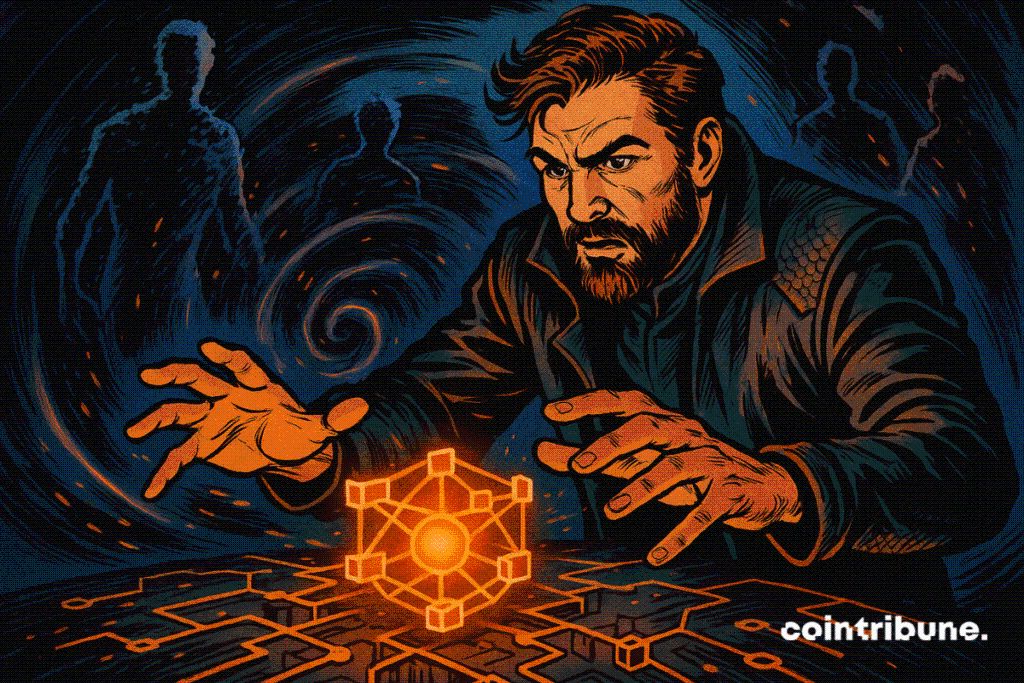Facing the Quantum Threat, Building Tomorrow's Web3 — Exclusive Interview with David Carvalho, CEO of Naoris
A silent revolution is taking shape. As quantum computing becomes a reality, the very foundations of Web3 begin to tremble. Behind this invisible threat, a solution emerges: Naoris Protocol. A decentralized post-quantum cybersecurity infrastructure, it anticipates vulnerabilities that even nation-states fear. Its founder, David Carvalho, grants us an exclusive interview. An ethical hacker turned cyber strategist, he shares his vision, his technological choices, and his warnings. As the $NAORIS Token Generation Event took place on July 31, 2025, a new paradigm is on the horizon..

In brief
- Naoris Protocol wants to protect Web3 with post-quantum cybersecurity.
- Its founder, David Carvalho, former ethical hacker and NATO advisor, warns of the urgency of Q-Day.
- Already 3.3M wallets created and 474M threats neutralized before the July 31, 2025 TGE.
Why Naoris? At the intersection of Web3 emergencies and the quantum threat
Web3 was built for resilience. Yet it still relies on cryptographic systems that quantum computers could render obsolete in the blink of an eye. Financial institutions, critical infrastructure, and governments are only now beginning to realize the risk: today’s cryptography can be broken, silently, by machines that officially don’t even exist yet.
In this context, Naoris Protocol’s mission is to provide a decentralized and trusted cybersecurity infrastructure, built from the ground up to withstand the coming age of quantum computing. This isn’t just a patch, it’s a structural reinvention powered by technologies like the Sub-Zero Layer, Swarm AI, Dilithium-5, and dPoSec.
And it’s backed by a recent $3 million strategic funding round led by Mason Labs, with participation from Frekaz Group, Level One Robotics, and Tradecraft Capital.
Key Stats
The results speak for themselves. Since releasing the testnet in early 2025:
- Over 3.3 million wallets created;
- Over 100 million post-quantum encrypted transactions executed;
- 1 million security nodes activated;
- 474 million threats detected and neutralized.
These numbers reflect lightning-fast adoption and unprecedented reactivity in the Web3 ecosystem.
Meet the Visionary: David Carvalho
David Carvalho is the founder, CEO, and Chief Scientist of Naoris Protocol. With over 20 years of experience as a Global Chief Information Security Officer and ethical hacker, he has also spent his career advising nation-states and critical infrastructures under NATO on cyber-war, cyber-terrorism, and cyber-espionage.
His vision is radical: if quantum adversaries already exist in secret labs, we must build infrastructure to survive the invisible. Not a patch—an architecture. That architecture rests on three pillars: post-quantum cryptography, decentralized validation, and automated collective intelligence.
David isn’t just imagining a resilient Web3. He’s constructing an antifragile digital civilization, ready to absorb shocks others won’t admit exist.
Exclusive Interview with David Carvalho
Can you present yourself and tell us what drove you to create Naoris Protocol?
I’m David Carvalho, founder, CEO, and Chief Scientist of Naoris Protocol. I’ve spent over 20 years as a Global Chief Information Security Officer and ethical hacker, advising nation-states and critical infrastructures under NATO on cyber-war, cyber-terrorism, and cyber-espionage.
The catalyst came in 2017 during a nation-state meeting with former Head of NATO Intelligence Committee Kjell Grandhagen. But what really drove me was understanding that quantum timelines aren’t theoretical. As Jay Gambetta, Vice President of IBM Quantum, warns:
The quantum threat isn’t coming—it’s here. Nation-states are harvesting encrypted data TODAY, betting they’ll decrypt it tomorrow.
We needed infrastructure built for adversarial quantum capabilities from day one.
Naoris presents itself as “The Base Layer of Trust & Security” — why do you think cybersecurity should be native to the infrastructure and not an added layer?
Because bolt-on solutions are dead on arrival against quantum threats . CIA leadership has been briefing Congress that quantum breakthroughs are happening faster than public research suggests. When intelligence agencies are harvesting encrypted communications at unprecedented scale, waiting for traditional security vendors to quantum-upgrade is strategic suicide.
We operate at the Sub-Zero Layer – below L0 to L3 – quantum-shielding transactions in real-time without hard forks. When quantum computers start breaking encryption en masse, traditional security layers crumble like dominoes. Native quantum-resistant infrastructure is the only thing that survives Q-Day.
More than 1.1 M wallets in one month: how do you explain this meteoric adoption?
That growth reflects institutional understanding that quantum transition windows are much shorter than public timelines suggest. NSA cryptographers have been privately advising Fortune 500 companies that quantum-resistant transitions need to happen immediately.
BlackRock didn’t add quantum computing warnings to their Bitcoin ETF filings for theoretical concerns – they’re seeing intelligence briefings showing quantum capabilities advancing faster than public research indicates. The smart money knows when quantum capabilities are officially announced, it’s already too late.
In a post-quantum world, which threats do you believe are currently underestimated by Web3 projects?
The timeline collapse. Web3 builders think they have until the 2030s. They’re catastrophically wrong. Defense Department briefings suggest quantum breakthroughs are happening behind classified doors right now.
According to Tilo Kunz of Quantum Defen5e, who briefed Defense Information Systems Agency officials, Q-Day could arrive much sooner than public timelines suggest. The data harvest is already complete – every blockchain transaction is sitting in quantum-ready archives waiting for decryption.
Nation-states won’t announce their quantum capabilities – they’ll exploit them silently while everyone else scrambles for solutions that no longer work.
In what way is Naoris Protocol truly post-quantum? Could you simply explain the algorithms (Dilithium-5, KEMs, etc.) used and why they are so important?
We built assuming quantum adversaries are already operational behind classified programs. Our Dilithium-5 signature schemes remain secure against quantum computers running Shor’s algorithm at scale. CRYSTALS-KYBER key encapsulation ensures even if quantum adversaries are intercepting all network traffic for future decryption, they can’t derive our encryption keys.
We’ve rebuilt the entire cryptographic stack assuming adversarial quantum capabilities that intelligence agencies hint at but won’t publicly confirm. Unlike academic research assuming gradual quantum development, we designed for sudden quantum superiority scenarios where adversaries achieve cryptographic dominance overnight.
IBM’s quantum roadmap shows exponential capability growth, but government quantum programs are typically decades ahead of commercial research.
Does your dPoSec (Decentralized Proof of Security) fundamentally change the role of validators? Can we say that each node becomes a cybersecurity agent?
Absolutely. Traditional validators become obsolete the moment quantum computers can forge consensus signatures. Our dPoSec validators are quantum-hardened cybersecurity agents that remain functional when quantum attacks break conventional blockchain security.
Each node runs threat detection algorithms designed to identify quantum-enabled attacks before they become public. When quantum computers start breaking blockchain consensus in real-time, our validators will be the only ones still operating legitimately.
We’re building the world’s largest quantum-resistant security mesh where every node contributes to collective defense against threats that intelligence agencies are already tracking but not publicly discussing.
Which industries today have the greatest demand for a solution like yours? And which are still lagging behind?
Financial services and defense contractors are quietly panicking because they’re getting classified briefings about quantum timelines that contradict public research. Banking executives who’ve seen NSA presentations are fast-tracking post-quantum transitions without waiting for industry standards.
Government contractors handling classified information are receiving direct orders to implement quantum-resistant infrastructure immediately. They’re not waiting for gradual transitions because intelligence agencies know quantum threats are already operational in certain capacities.
The biggest laggards are crypto projects that think they have time for committee decisions. Most DeFi protocols are building on quantum-vulnerable infrastructure while promising long-term security – it’s delusional given what intelligence agencies know about quantum development timelines.
With more than 474 million cyber threats blocked on the testnet, can you give us a concrete example of an attack that was detected and neutralized?
We’ve neutralized sophisticated phishing campaigns using malware distribution through compromised browser extensions targeting crypto wallets. The malware captures private keys and seed phrases when users access their wallets.
We stopped massive deanonymization attacks where adversaries correlated on-chain transactions with browser fingerprinting to unmask wallet owners. They built detailed profiles linking crypto holdings to real identities through browser capabilities and transaction timing patterns.
We’ve identified anonymization stripping attacks targeting privacy coin users, using cross-chain analysis combined with browser exploitation to pierce anonymization layers. These attacks specifically target mixing services by correlating browser data with blockchain analysis.
Another major threat involved crypto data harvesting through compromised browser extensions stealing wallet information, credit card data, and banking credentials stored in browsers for comprehensive financial profiling.
Our quantum-aware algorithms detected preparation attacks where adversaries test browser security capabilities to map vulnerabilities for future quantum exploitation once quantum computers can crack encryption protecting stored credentials.
The $NAORIS token is at the heart of your infrastructure. Could you explain its exact role?
$NAORIS is fundamentally different – it’s a machine-to-machine communication and consensus creation token that certifies, validates, and provides security assurance at post-quantum levels for infrastructure applications and hardware.
Whether it’s running processes, applications, or operations that require cryptographic proof of state, $NAORIS enables machines to autonomously validate security without human intervention. Unlike most tokens that are human-driven and volatile, $NAORIS is machine-to-machine driven, making it inherently more resistant to market downturns.
The token enables autonomous security validation between devices, systems, and infrastructure components. Machines stake and earn $NAORIS based on security performance, creating an economy where cybersecurity becomes automated and economically incentivized at the infrastructure level.
What will be the major milestones for the project in the 6 to 12 months following the TGE?
Our core objective is bridging Web3 and Web2, transforming traditional infrastructures that are centralized single points of failure into highly resistant, validated environments backed by hundreds of millions of nodes.
We’re targeting the quantum transition window when current cryptography starts failing but before alternative infrastructure becomes available. Enterprise adoption will accelerate as classified quantum capabilities become public knowledge.
Our quantum threat intelligence platform will provide early warning when quantum computers achieve cryptographic relevance, tracking operational quantum capabilities that governments prefer to keep classified.
We’re building for the moment when quantum superiority creates sudden, catastrophic demand for infrastructure that remains cryptographically legitimate. When quantum computers start breaking traditional security en masse, we’ll be the only network with hundreds of millions of quantum-resistant nodes still operating legitimately.
A Safety Net for the Quantum Storm
By combining scientific rigor with strategic vision, David Carvalho is paving the way for a viable Web3 beyond Q-Day. The Token Generation Event of Naoris Protocol’s native token, $NAORIS took place on July 31, 2025. Follow their latest updates on the Naoris Protocol website and on X for more information on the project’s development.
Disclaimer: The content of this article solely reflects the author's opinion and does not represent the platform in any capacity. This article is not intended to serve as a reference for making investment decisions.
You may also like
Bitcoin Price Prediction: Can BTC Break Out of the $89K Range This Week?
Sovereign Wealth Funds Were Buyers as Bitcoin Plunged: BlackRock's Larry Fink

ETH price fluctuates sharply: Event review and in-depth outlook
I spent eight years of my youth sinking into the crypto "casino"

